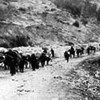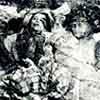|
background – war and imperial collapse
 The collapse of the Ottoman Empire dramatically rearranged the map of a vast region. What was once a sprawling, multi-ethnic empire splintered into more than two-dozen new nations, from the Balkans to the Caucasus to the Arabian peninsula. Across the surface of these lands unfolded a profound human tragedy. Nearly incessant war crippled the Ottoman economy. It left towns devoid of men to care for households or to tend crops. Military requisitions drained the countryside of livestock and many of the labor-saving implements of daily life. Disease ran rampant and famine struck many. The collapse of the Ottoman Empire dramatically rearranged the map of a vast region. What was once a sprawling, multi-ethnic empire splintered into more than two-dozen new nations, from the Balkans to the Caucasus to the Arabian peninsula. Across the surface of these lands unfolded a profound human tragedy. Nearly incessant war crippled the Ottoman economy. It left towns devoid of men to care for households or to tend crops. Military requisitions drained the countryside of livestock and many of the labor-saving implements of daily life. Disease ran rampant and famine struck many.
vast population movements
 As new states coalesced, large population masses streamed across the landscape, some fleeing the path of war, some seeking new lives among ethnic brethren or co-religionists, some having suffered expulsion, and some obeying negotiated population exchanges. Two such major movements were (a) the flight of Muslim refugees from newly-established Christian states in Balkans and the Caucasus into what would become modern Turkey during the period roughly between 1821 and 1922, and (b) the relocation of much of the Ottoman Armenian population from the war zone of eastern Anatolia into Ottoman domains in Syria, mainly in 1915-16. As new states coalesced, large population masses streamed across the landscape, some fleeing the path of war, some seeking new lives among ethnic brethren or co-religionists, some having suffered expulsion, and some obeying negotiated population exchanges. Two such major movements were (a) the flight of Muslim refugees from newly-established Christian states in Balkans and the Caucasus into what would become modern Turkey during the period roughly between 1821 and 1922, and (b) the relocation of much of the Ottoman Armenian population from the war zone of eastern Anatolia into Ottoman domains in Syria, mainly in 1915-16.
a genuine historic controversy
 History records the enormous human suffering from both of these events: Perhaps 5.5 million Muslims, mostly Turks, died as refugees or were killed in the years immediately preceding and during World War I, as well as through the formative years of the Republic of Turkey. And certainly hundreds of thousands of Armenians died during the Armenian Revolt and the relocations consequently ordered by the Ottoman government. Scholars on the Ottoman Empire continue to examine the details and causes of these twin tragedies. What they have uncovered is not a singular tale of Christian woe, but rather a complex story that, if presented as evidence, would make it highly unlikely that a genocide charge could be sustained against the Ottoman government or its successor before a neutral arbiter. History records the enormous human suffering from both of these events: Perhaps 5.5 million Muslims, mostly Turks, died as refugees or were killed in the years immediately preceding and during World War I, as well as through the formative years of the Republic of Turkey. And certainly hundreds of thousands of Armenians died during the Armenian Revolt and the relocations consequently ordered by the Ottoman government. Scholars on the Ottoman Empire continue to examine the details and causes of these twin tragedies. What they have uncovered is not a singular tale of Christian woe, but rather a complex story that, if presented as evidence, would make it highly unlikely that a genocide charge could be sustained against the Ottoman government or its successor before a neutral arbiter.
Thus, whether the tragic suffering of the Ottoman Armenians meets the definition of the crime of genocide as provided by the United Nations Genocide Convention [web] remains a genuine historic controversy. Moreover, the notion that the one-sided Armenian narrative is settled history must be utterly rejected so that researchers will feel free to delve into the details of these contested events.
questions considered
Among the work of the scholars below, many of whom are Ottoman history experts, are considerations of the following questions:
- Is the genocide label, which is so vigorously promoted by Armenian advocacy organizations appropriate?
- Did the Ottoman government during World War I possess the requisite intent described by the U.N. Genocide Convention, to destroy the Armenians?
- What was the Armenian Revolt and how did it impact the Ottoman government’s decision to relocate Armenian civilians from eastern Anatolia?
- What was the ultimate toll upon the Armenian population? And how many deaths could be attributed to the various causes: intercommunal warfare, starvation, exposure, massacre, disease, etc.?
- What was the ultimate toll upon the Ottoman Muslim population embroiled in these same events? And how many deaths can be attributed to the same causes?
Their work establishes a better basis upon which to address historic grievances than the one-sided narrative most often provided in media accounts and by Armenian lobbyists and their advocates. In effect, these scholars provide the oft-ignored historical context, which is critical to any explanation of the shared past of the Turkish and Armenian peoples.
At a minimum, the list below demonstrates that in fact, there exists no common agreement that the genocide label is appropriate and that, contrary to assertions made by Armenian lobby groups, the details of the historic narrative remain open to further study and interpretation.
the impact of physical and academic intimidation
Sadly, this list likely under-represents the number of scholars who would challenge the conventional wisdom on the Armenian tragedy. Those who write from a contra-genocide perspective have had to do so under extraordinary risk. Merely because of something he wrote, the home Prof. Stanford Shaw of U.C.L.A. was firebombed. Death threats have been received by Justin McCarthy and his family. The university press that published Guenter Lewy’s latest work was harassed by two Armenian scholars. (See, Ethnic Cleansing or Genocide?, by Masaki Kakiszaki, Critique: Critical Middle Eastern Studies, Vol. 16, No. 1, 85–92, Spring 2007.) The University of Southern California in 2006 buckled to the vociferous protest of an Armenian pressure group and canceled a symposium by two former Turkish diplomats. Meanwhile, foreign nations such as France and Switzerland have rendered it against the law even to hold the contra-genocide viewpoint. Princeton University’s Bernard Lewis was famously fined by a French court in 1995 for such an “offense.” And, the Armenian terrorist organizations ASALA and JCAG carried out no fewer than 73 acts of terrorism in North America alone, killing 16 people. Around the world, Armenian terrorists killed at least 50 more people, mostly Turkish diplomat murdered in planned assassinations and injured over 500, all in the name of “genocide recognition.” In short, the chilling effect this has had on free discussion and open debate on the history of the late Ottoman Empire has been genuine and severe, lowering a curtain of fear over the consideration of this important era of world history.
additions and subtractions
 Our aim is to evaluate as closely as possible each name on the list based on the published statements or writings of each scholar that are readily available. We welcome visitor suggestions for additions to the list. And likewise, if you believe that a particular name ought not be on the list, please let us know. Our goal is to continue to openly discuss and debate the details of history and the genocide allegation. For feedback, please contact info@tc-america.org Our aim is to evaluate as closely as possible each name on the list based on the published statements or writings of each scholar that are readily available. We welcome visitor suggestions for additions to the list. And likewise, if you believe that a particular name ought not be on the list, please let us know. Our goal is to continue to openly discuss and debate the details of history and the genocide allegation. For feedback, please contact info@tc-america.org
|

